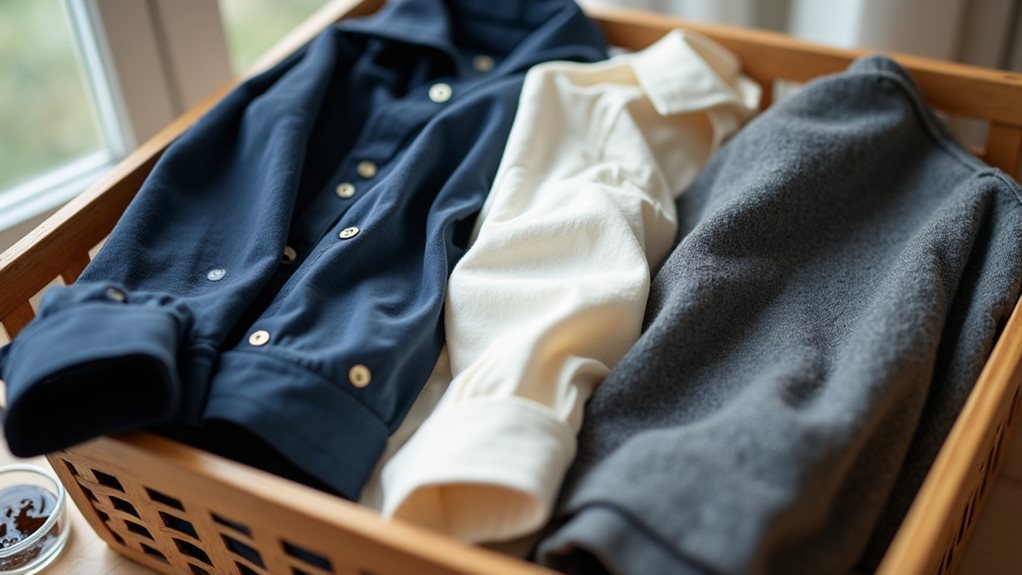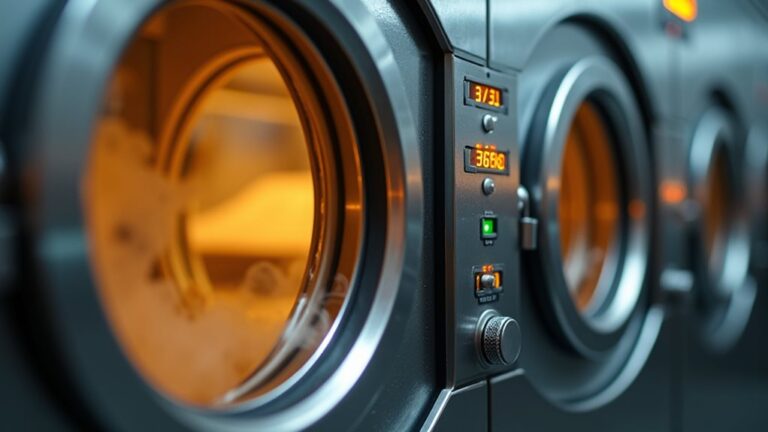You don’t need to wash clothes before dry cleaning—it’s actually counterproductive and can damage delicate fabrics or set stains deeper into fibers. Instead, check care labels for that circle with “P” symbol indicating dry clean only, empty all pockets to avoid damage from coins or pens, and mark visible stains with tape so your cleaner knows where to focus their attention. The specialized solvents professionals use work best on untreated garments, though certain circumstances might change this approach.
Understanding When Pre-Washing Is Necessary
While I used to frantically pre-wash every single garment before heading to the dry cleaner—thinking I was being helpful, bless my overthinking heart—I’ve learned that this extra step is usually unnecessary and sometimes even counterproductive.
The truth is, dry cleaning is specifically designed to tackle dirt and grime without water, making pre-washing redundant for most situations.
However, there are exceptions worth considering. If you notice obvious stains on your garments, addressing them quickly at home can prevent them from setting permanently.
Always check your care label first though—if it says “dry clean only,” resist the urge to wash at home, as you might damage delicate fabrics and end up with an expensive mistake.
Professional dry cleaners use specialized solvents that can effectively clean garments without the need for pre-washing, and they’re equipped with the proper techniques to handle even heavily soiled items.
Checking Care Labels and Fabric Requirements
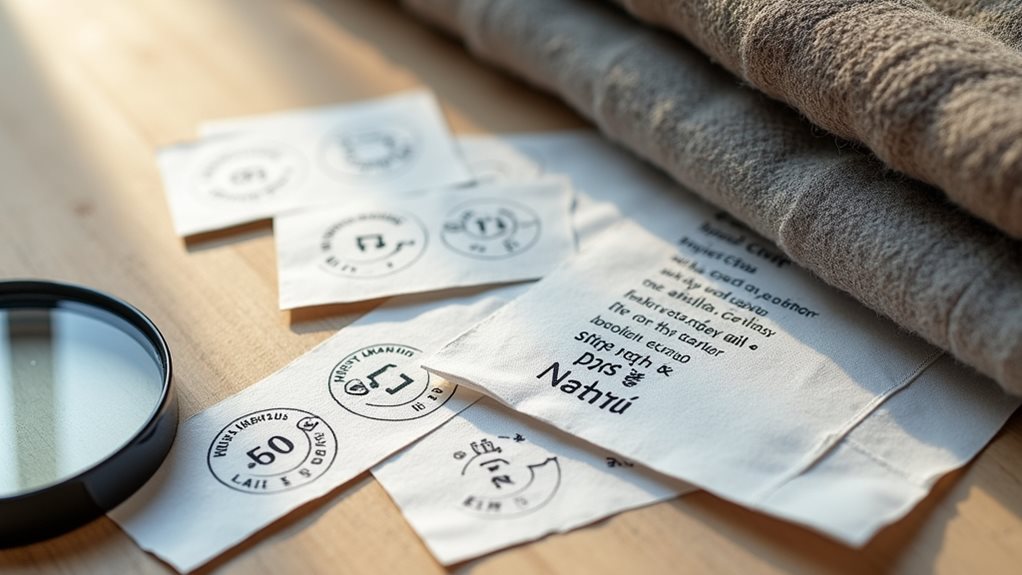
Before you toss that silk blouse into the washing machine or send it straight to the dry cleaner, you’ll want to become best friends with those tiny care labels that manufacturers sew into garments—trust me, I learned this the hard way after shrinking my favorite cashmere sweater 😅.
These little fabric guides contain symbols and instructions that tell you exactly whether your clothes need pre-washing, require dry cleaning only, or can handle both treatments depending on the situation.
Understanding what these care symbols mean, along with knowing how different fabrics like wool, silk, and cotton respond to various cleaning methods, will save you from costly mistakes and help you make informed decisions about your garment care routine.
Structured clothing items like blazers and suits typically benefit most from professional dry cleaning, as this specialized method helps maintain their shape and construction better than traditional home washing methods. Learning to identify which garments fall into the delicate fabrics category will help you determine the most appropriate cleaning approach for each item in your wardrobe.
Understanding Care Label Symbols
When I first started doing my own laundry in college, I’ll admit I was one of those people who ignored those tiny tags sewn into the seams of my clothes—and boy, did I pay the price when my favorite wool sweater turned into something that would’ve fit my little sister perfectly 😅.
Now I’m passionate about helping you decode those care instructions before disaster strikes. Look for the circle symbol with a “P” inside, which screams “dry clean only item” loud and clear.
A bucket icon means machine washing‘s okay, while a hand in water suggests gentle hand washing. Understanding these cleaning methods symbols isn’t rocket science, but it’ll save your wardrobe from becoming expensive casualties.
You’ll also want to watch for symbols with diagonal lines or X marks that indicate certain dry cleaning methods are prohibited for your specific garment.
Fabric-Specific Cleaning Requirements
Since different fabrics have their own personalities—much like people, honestly—you’ll need to treat each piece in your wardrobe with the respect it deserves, and that means diving deep into those care labels I mentioned earlier.
Understanding fabric-specific cleaning requirements isn’t just about following rules; it’s about preserving your investment and avoiding those heartbreaking “oops” moments we’ve all experienced.
Delicate fabrics like silk and velvet demand professional dry cleaning from the start—no pre-washing required or recommended. Those care tags marked “dry clean only” aren’t suggestions; they’re lifelines for your garments’ structural integrity.
However, machine-washable cottons and polyesters offer more flexibility, though washing before dry cleaning typically isn’t necessary since professional cleaners handle surface dirt effectively anyway.
Structured clothing such as suits and blazers should always go directly to dry cleaning to maintain their shape and professional appearance.
Handling Visible Stains and Heavy Soiling
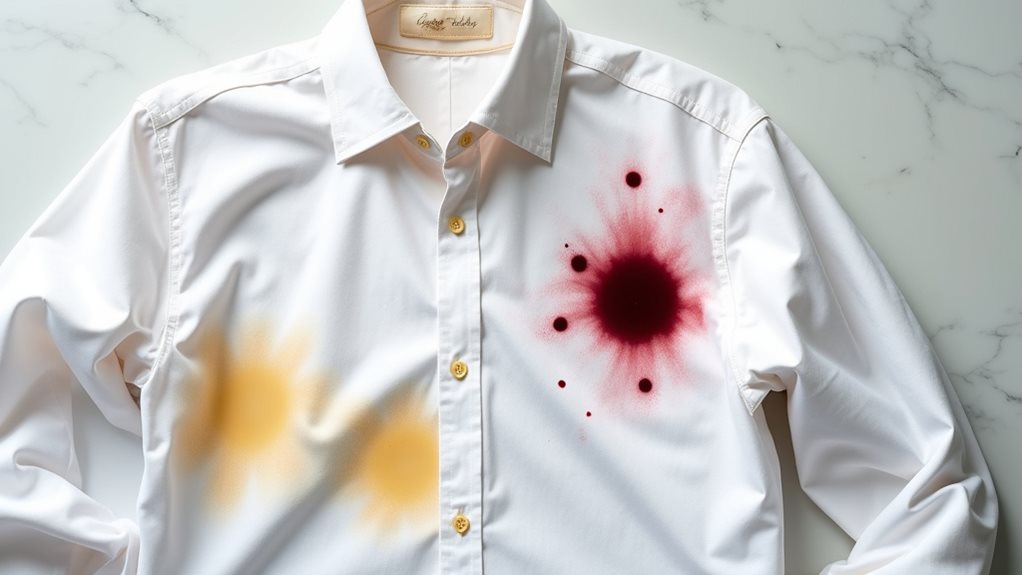
One glaring mistake I made early in my dry cleaning adventures was dropping off a silk blouse with a mysterious red stain, assuming the professionals would just figure it out—spoiler alert, they didn’t, and I learned the hard way that visible stains need your attention before you hand over your precious garments.
Now I always mark stains with safety pins and tell my cleaner exactly what happened—wine spill at dinner, coffee mishap during morning rush, you name it.
For heavy soiling, I’ve discovered that mentioning specific concerns upfront makes all the difference, since different cleaning methods work better for various stains, and pre-treatment often saves the day when regular cleaning falls short.
While dry cleaning excels at removing oil-based stains and grease that water-based washing can’t handle, the age of the stain and fabric type still play crucial roles in determining success rates.
Preparing Garments for Optimal Dry Cleaning Results

Before you hand over that favorite blazer or delicate dress, you’ll want to take a few simple steps that can make the difference between good results and exceptional ones.
Start by checking those care labels—I learned this the hard way when my silk scarf came back looking like a crumpled napkin because I assumed it was dry-clean safe 😅—then empty every single pocket, including that tiny coin pocket you always forget about.
Look for the standard circle symbol on the care label, which indicates that the garment requires professional dry cleaning rather than home washing.
Finally, grab a piece of tape or sticky note to mark any stain areas, because while dry cleaners are skilled professionals, they’re not mind readers who can spot that barely-visible wine drip from your anniversary dinner.
Check Care Labels
While fumbling through my closet last weekend, I grabbed what I thought was my trusty cotton blazer for an important meeting, only to discover later that it was actually a delicate silk blend that I’d nearly ruined with my overzealous pre-treatment routine.
This rookie mistake taught me the golden rule: always check care labels before doing anything to your clothes, especially before taking them to a cleaning service. Those tiny tags aren’t just manufacturer suggestions—they’re your garment’s survival guide.
When you see “dry clean only,” resist the urge to remove stains yourself with harsh chemicals or water-based solutions. If you encounter “dry clean recommended” labels, you’ll have more flexibility since these garments can be safely dry cleaned but don’t necessarily require it, unlike the mandatory “dry clean only” instruction. Instead, point out any spots to your dry cleaner and let the professionals handle it properly.
Empty All Pockets
Although it sounds embarrassingly obvious, I can’t tell you how many times I’ve sheepishly returned to my dry cleaner after discovering I’d left something important in a pocket—like the time I nearly lost my grandmother’s vintage pearl earrings because they were tucked away in my coat pocket, completely forgotten until I frantically searched for them the next morning.
You absolutely must empty all pockets before dropping off your garments, and here’s why this step matters so much:
- Coins and keys can damage delicate fabrics during the cleaning process
- Pens and markers create permanent stains that are nearly impossible to remove
- Forgotten valuables might get lost or damaged beyond repair
- Hidden items prevent your dry cleaner from identifying potential cleaning issues
This simple habit protects your belongings while guaranteeing the seamless possible cleaning experience. Remember that fabric type plays a crucial role in determining how frequently your garments should be professionally cleaned, so always check pockets thoroughly to avoid any cleaning complications that could affect delicate materials.
Mark Stain Areas
Three years ago, I learned this lesson the hard way when I dropped off my favorite silk blouse with what I thought was an “obvious” red wine stain near the collar, only to pick it up later with the stain still there because my dry cleaner had somehow missed it entirely during the cleaning process.
Now I always mark stain areas using masking tape or safety pins, which makes those pesky spots impossible to overlook.
You’ll want to include a note describing what caused each stain, whether it’s coffee, makeup, or mystery sauce from last night’s dinner 😅.
This simple step dramatically improves your cleaning results while preventing additional damage during treatment.
Different stain types respond differently to chemical solvents, with oil-based stains typically being easier to remove than water-based marks like blood or sweat.
Chemical Sensitivity and Pre-Washing Considerations
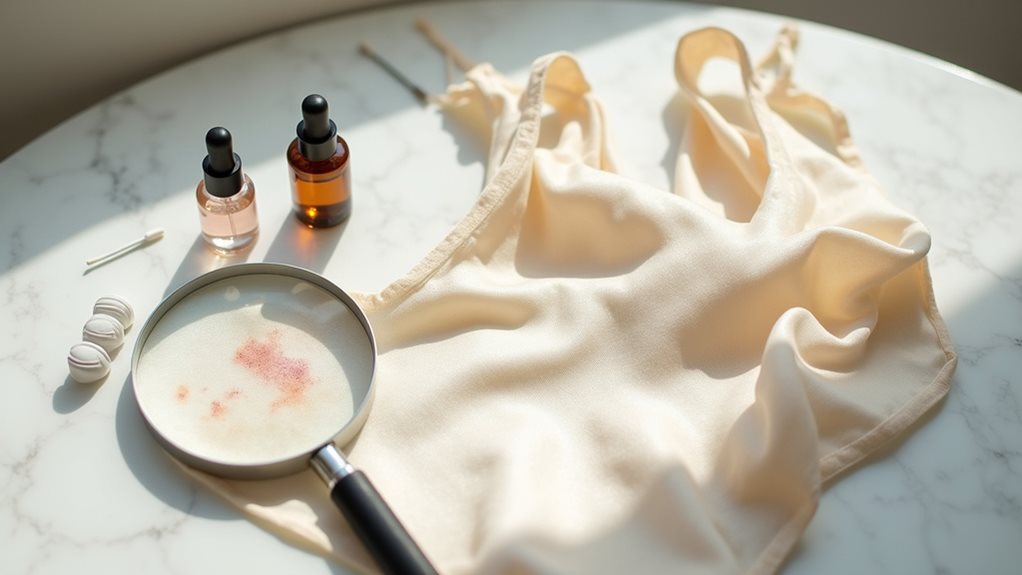
If you’re someone who breaks out in hives from certain fabrics or finds yourself sneezing when you slip on that gorgeous new blazer, you’re definitely not alone in wondering whether a quick pre-wash might save your skin—literally.
Chemical sensitivity affects more people than you’d think, and those manufacturing residues can be real troublemakers for sensitive souls.
Pre-washing can help eliminate irritating chemicals, but here’s where things get tricky:
- Check care labels first—some fabrics shrink or bleed when washed
- Delicate materials might suffer irreversible damage from water
- Consider your reaction severity before risking garment integrity
- Test wash similar fabric scraps if you’re unsure
Sometimes protecting your skin means sacrificing that perfect fit, but honestly? Your comfort matters more than looking flawless while scratching mysteriously. 😅
While modern dry cleaning uses safer alternatives like hydrocarbon solvents and liquid CO2, some people with severe chemical sensitivities may still prefer pre-washing to remove any potential irritants before professional cleaning.
Professional Cleaning vs. Home Pre-Treatment Methods

When you’re standing in your closet holding that wine-stained silk blouse, wondering whether to grab the Tide pen or head straight to the dry cleaner, you’re fundamentally choosing between two completely different cleaning philosophies.
That moment of hesitation with a stained garment in hand perfectly captures the eternal debate between quick fixes and professional care.
Home pre-treatment works wonders for cotton and synthetic fabrics, but delicate materials like silk or wool can actually suffer damage from DIY attempts.
Professional dry cleaning uses specialized solvents that penetrate fibers without the harsh agitation of washing machines, making it your safest bet for preserving expensive garments.
However, don’t completely dismiss home methods – sometimes a gentle spot treatment before professional cleaning creates the perfect one-two punch.
Always check those care instructions first, because trust me, I’ve learned the hard way that some fabrics are unforgiving! 😅
Special Circumstances That Require Pre-Washing
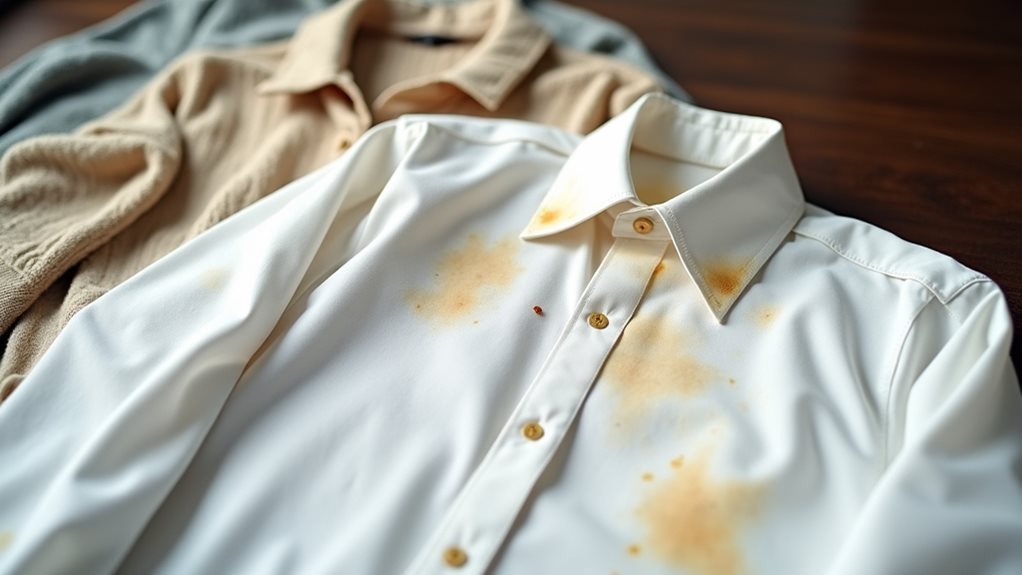
While most garments can go straight from your closet to the dry cleaner without any fuss, certain situations absolutely demand that you break out the washing machine first, and I’ve discovered these exceptions through some pretty memorable mishaps over the years.
Trust me, pre-washing becomes crucial when you’re dealing with delicate fabrics that need extra TLC or stubborn stains that’ll set permanently if ignored.
Here’s when you absolutely can’t skip this step:
- Visible stains that could become permanent during dry cleaning
- Garments with body oils or strong odors from previous wear
- Items stored long-term that’ve collected dust and allergens
- Heavily embellished pieces where gentle pre-treatment prevents damage
Your silk blouses and lace treasures especially deserve this careful attention! 😊
Best Practices for Garment Preparation
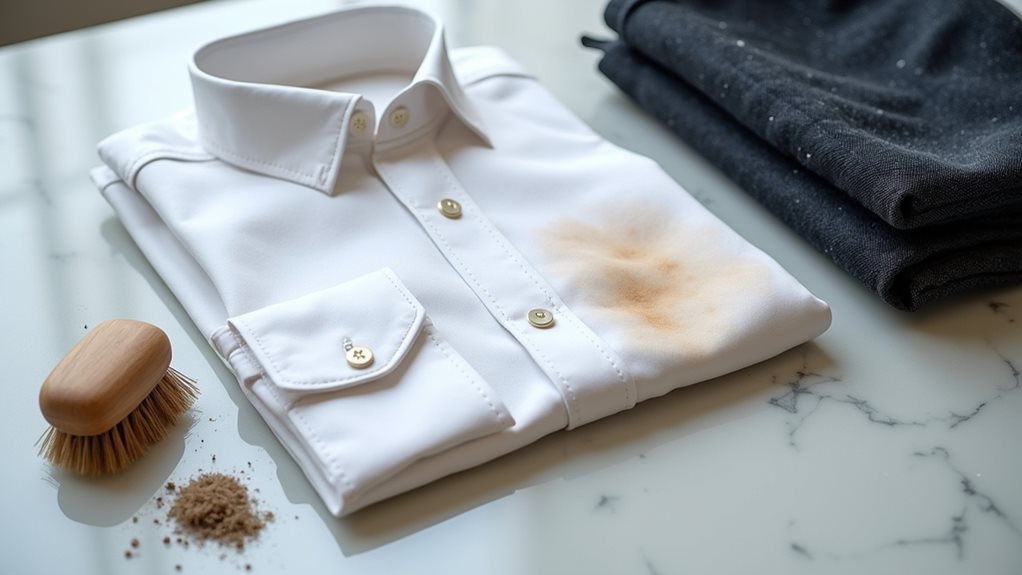
Although dry cleaning eliminates the need for pre-washing in most cases, proper garment preparation can make the difference between clothes that come back looking refreshed and those that return with the same issues you hoped to resolve.
Proper preparation before dry cleaning transforms mediocre results into professionally refreshed garments that truly look their best.
I learned this lesson the hard way when I sent my favorite blazer to dry cleaners without checking the pockets, only to discover my emergency twenty-dollar bill had turned into confetti 😅.
Now I always empty pockets completely, checking every zipper and hidden compartment twice.
To properly prepare your garments, mark any stubborn stains with a note or symbol, inspect for missing buttons or loose threads, and place everything neatly in a garment bag.
These simple steps help professional cleaning kits work more effectively, guaranteeing your clothes receive the targeted care they deserve.

